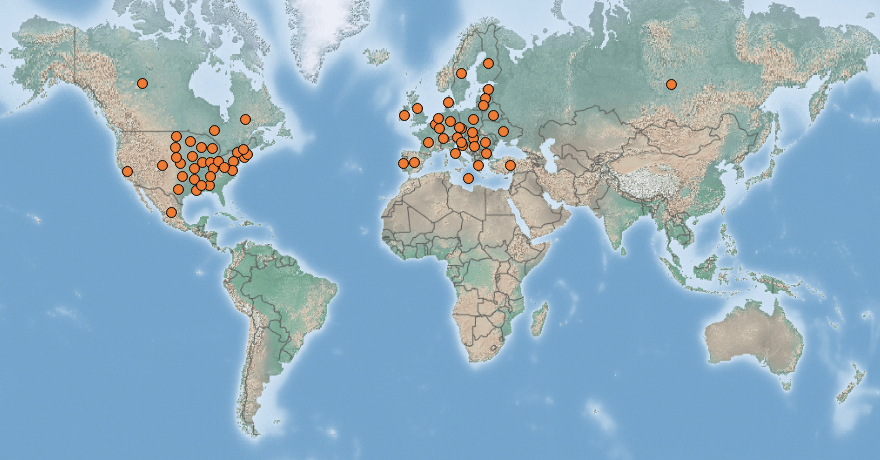 |
Zebra mussel | Status LU: established. 1st record: <1892. |
 |
Zebramuschel | Status Eur.: established. |
 |
Moule zébrée | RA: ISEIA: A2, Black List. Harmonia+: n/a. |
 |
Zebramuschel | Wikipedia:     | Wikispecies: n/a | CABI | Wikispecies: n/a | CABI |
 |
Driehoeksmossel | Back to the list of invertebrates |
Contents
Report the species
→ Report Dreissena polymorpha to the National Museum of Natural History.
Brief description
 To date, D. polymorpha has been the most aggressive freshwater invader worldwide. Dreissenids are the only freshwater bivalves that attach to hard substrates in high densities and have a planktonic larval stage. This life history facilitates their abilities as invaders, and allows them to become enormously abundant when introduced into a new water body. Once introduced their populations can grow rapidly, and the total biomass of a population can exceed 10 times that of all other native benthic invertebrates. D. polymorpha is native to the drainage basins of the Black, Caspian and Aral Seas. During the nineteenth century its range has expanded westward to most of western Europe, the UK, and North America, where it is found in the Great Lakes and all major river drainages east of the Rocky Mountains and causes multiple economic impacts on fisheries, aquaculture, water attractions and aquatic transport (CABI 2019).
To date, D. polymorpha has been the most aggressive freshwater invader worldwide. Dreissenids are the only freshwater bivalves that attach to hard substrates in high densities and have a planktonic larval stage. This life history facilitates their abilities as invaders, and allows them to become enormously abundant when introduced into a new water body. Once introduced their populations can grow rapidly, and the total biomass of a population can exceed 10 times that of all other native benthic invertebrates. D. polymorpha is native to the drainage basins of the Black, Caspian and Aral Seas. During the nineteenth century its range has expanded westward to most of western Europe, the UK, and North America, where it is found in the Great Lakes and all major river drainages east of the Rocky Mountains and causes multiple economic impacts on fisheries, aquaculture, water attractions and aquatic transport (CABI 2019).
Status and distribution in Luxembourg
Records of Dreissena polymorpha (Pallas, 1771) in Luxembourg. Data source: Recorder-Lux, iNaturalist & GBIF, 2024-07-27.
An identification sheet of the species has been published by the MECDD in French and German.
Risk assessment
ISEIA protocol
A2 (3+3+3+3) = Black List (Ries et al. 2017: 68).
Harmonia+ protocol
Not assessed yet.
Worldwide distribution
Bibliography
- CABI, 2019. Dreissena polymorpha (Pallas, 1771). In: Invasive Species Compendium. Wallingford, UK: CAB International. URL: www.cabi.org/isc [accessed 2020-04-21]
- Dhur, G. & J.A. Massard, 1995. Étude historique et faunistique des Invertébrés immigrés ou introduits dans la Moselle luxembourgeoise et ses affluents. Bull. Soc. Nat. luxemb. 96: 127-156. [PDF 1896 KB]
- Ferrant, V., 1892. Beiträge zur Molluskenfauna des Grossherzogtums Luxemburg (Schluss). Bull. Soc. Nat. luxemb. 2: 21-26. [PDF 419 KB]
- MNHNL, 2000-. Dreissena polymorpha (Pallas, 1771) in Recorder-Lux, database on the natural heritage of the Grand Duchy of Luxembourg. Musée national d’histoire naturelle, Luxembourg. URL: https://mdata.mnhn.lu [Accessed 2019-10-24]
- MNHNL, iNaturalist & GBIF, 2019. Dreissena polymorpha (Pallas, 1771) in MNHNL-mdata, online portal combining species observation from Recorder-Lux, iNaturalist and GBIF. National Museum of Natural History, Luxembourg. URL: https://mdata.mnhn.lu [Accessed 2019-10-24]
- Ries, C., A. Arendt, C. Braunert, S. Christian, A. Dohet, A. Frantz, G. Geimer, M. Hellers, J. A. Massard, X. Mestdagh, R. Proess, N. Schneider & M. Pfeiffenschneider, 2017. Environmental impact assessment and black, watch and alert list classification after the ISEIA Protocol of invertebrates in Luxembourg. Bull. Soc. Nat. luxemb. 119: 63-70. [PDF 360 KB]
Suggested citation of this webpage
Ries, C. & M. Pfeiffenschneider (Eds.), 2024. Dreissena polymorpha (Pallas, 1771). In: neobiota.lu - Invasive Alien Species in Luxembourg. National Museum of Natural History, Luxembourg. URL: https://neobiota.lu/dreissena-polymorpha/ [Accessed 2024-07-27].
Page content last updated on 2023-08-17.


